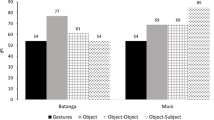Abstract
This study investigated the ability of a captive chimpanzee (Pan troglodytes) to recognise when he is being imitated. In the experimental condition of test 1a, an experimenter imitated the postures and behaviours of the chimpanzee as they were being displayed. In three control conditions the same experimenter exhibited (1) actions that were contingent on, but different from, the actions of the chimpanzee, (2) actions that were not contingent on, and different from, the actions of the chimpanzee, or (3) no action at all. The chimpanzee showed more “testing” sequences (i.e., systematically varying his actions while oriented to the imitating experimenter) and more repetitive behaviour when he was being imitated, than when he was not. This finding was replicated 4 months later in test 1b. When the experimenter repeated the same actions she displayed in the experimental condition of test 1a back to the chimpanzee in test 2, these actions now did not elicit those same testing sequences or repetitive behaviours. However, a live imitation condition did. Together these results provide the first evidence of imitation recognition in a nonhuman animal.


Similar content being viewed by others
Notes
A humorous example of the Marx Brothers showing this type of behaviour can be viewed at: http://xroads.virginia.edu/~MA01/Cober/marx/mirrormovie.html.
References
Asendorpf JB, Warkentin V, Baudonnière P-M (1996) Self-awareness and other-awareness II: mirror self-recognition, social contingency awareness, and synchronic imitation. Dev Psychol 32:313–321
Carpenter M, Tomasello M, Savage-Rumbaugh S (1995) Joint attention and imitative learning in children, chimpanzees, and enculturated chimpanzees. Soc Dev 4:217–237
Meltzoff AN (1990) Foundations for developing a concept of self: the role of imitation in relating self to other and the value of social mirroring, social modelling, and self practice in infancy. In: Cicchetti D, Beeghly M (eds) The self in transition: infancy to childhood. University of Chicago Press, Chicago, pp 139–164
Meltzoff AN, Decety J (2003) What imitation tells us about social cognition: a rapprochement between developmental psychology and cognitive neuroscience. Philos Trans R Soc Lond B 358:491–500
Nadel J (2002) Imitation and imitation recognition: functional use in preverbal infants and nonverbal children with autism. In: Meltzoff AN, Prinz W (eds) The imitative mind: development, evolution, and brain bases. Cambridge University Press, Cambridge, pp 63–73
Nagell K, Olguin R, Tomasello M (1993) Processes of social learning in the tool use of chimpanzees (Pan troglodytes) and human children. J Comp Psychol 107:174–186
Nielsen M, Dissanayake C (2004) Pretend play, mirror self-recognition and imitation: a longitudinal investigation through the second year. Infant Behav Dev (in press)
Perner J (1991) Understanding the representational mind. MIT, Cambridge, Mass.
Shrout PE, Fleiss JL (1979) Intraclass correlations: uses in assessing rater reliability. Psychol Bull 86:420–428
Suddendorf T, Whiten A (2001) Mental evolution and development: evidence for secondary representation in children, great apes and other animals. Psychol Bull 127:629–650
Tomasello M, Savage-Rumbaugh ES, Kruger AC (1993) Imitative learning of actions on objects by children, chimpanzees, and enculturated chimpanzees. Child Dev 64:1688–1705
Whiten A, Custance DM, Gomez JC, Teixidor P, Bard KA (1996) Imitative learning of artificial fruit processing in children (Homo sapiens) and chimpanzees (Pan troglodytes). J Comp Psychol 110:3–14
Acknowledgements
A University of Queensland Early Career Research Grant (122524853) to M.N. and an Australian Research Council Discovery Grant (DP0208300) to T.S. funded the work described in this article. We also wish to acknowledge the kind cooperation of the staff of the Rockhampton Botanical and Zoological Gardens. These experiments comply with the current laws of Australia regarding the use of animals in research.
Author information
Authors and Affiliations
Corresponding author
Appendix 1
Appendix 1
Table 2
Rights and permissions
About this article
Cite this article
Nielsen, M., Collier-Baker, E., Davis, J.M. et al. Imitation recognition in a captive chimpanzee (Pan troglodytes). Anim Cogn 8, 31–36 (2005). https://doi.org/10.1007/s10071-004-0232-0
Received:
Revised:
Accepted:
Published:
Issue Date:
DOI: https://doi.org/10.1007/s10071-004-0232-0




